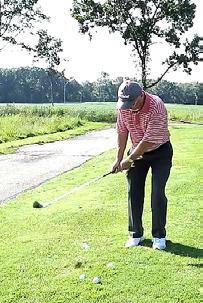
3 minute read
Instruction
by Let's Golf
inStructiOn No-Wrist Chipping
Jon Reese, PGA
Advertisement
Let’s start with the short game (putts, chips and pitches) because this is the part of the game that relies more on technique, rather than a lot of strength. Starting with the short game, you can immediately start lowering your score. All you need to do is get the ball near the green, chip or pitch and hopefully then make a short putt. These short shots are mini versions of long putts and full swings.
The simplest motion in golf is a putt. Bend over from the waist, flex your knees, face the ball with your eyes over (or nearly over) the ball, bend your elbows a bit in a comfortable fashion, and you are now set up to make a putt. Get an image of where the cup is, rock your shoulders back, carrying your arm swing and club along, rock back through and extend your trail arm for the length of the putt through the ball to the cup. You have now made a putt. Add a shift toward the target and you have also made the motion of a chip. Again, for chipping it is rock, shift, and extend. No wrists!
When you add wrist action for short shots, you are adding a complexity that may not be necessary. In a greenside short game shot, adding wrist action, as well as a taller posture, often promotes an overswing, lack of proper weight shift, and could cause the player to mishit the ball. All of which can contribute to poor contact or over-shooting the target.
The difference between a chip and a pitch is you don’t use your wrists when you chip. A chip or a pitch is not based on the distance or trajectory to the hole but on the type of stroke you use. A chip is much like a putt in its motion, but as you require more distance and move off the green and more friction from the various lies, the stroke becomes bigger and there is more of a hit involved. Use your shoulder motion to create a little more momentum, shift forward more (toward the target), and extend your trail arm out more, based on how much friction in the lie, distance, and trajectory you need.
In a pitch, the setup is like a normal short-iron swing. You use your wrists to extend your trail arm to deliver the blow. With both chips and pitches, the action is married to your shift through the ball.
In playing the game, the course always asks one question: What are you going to do now? From that question, you need to ask yourself, what is the ball telling you? Is it a putt, chip, or a pitch? Do I need more up or do I need more out? Do I need a gouge or brush? Does the shot require a follow-through (drag) or a follow-through that abruptly stops (pop)?
Brush and gouge are exactly what they sound like. How you come down into the ball. You brush the grass with a sweeping motion or gouge the ground taking grass and dirt. The brush is a shallow (low) angle of descent, and a gouge is a steeper (higher) angle of descent. The brush requires a wider and not so “up” backswing, and a gouge needs a more elevated backswing to come more down.
There are two different follow-throughs. Drag through or pop and stop. Drags go farther than pops.
With both arms bent at address, straighten the lead arm back for a brush shot. For a gouge shot just bend the trail elbow more up into the torso as you rock back for more elevation to hit down. Weight is distributed in reference to the ball position. If the ball is back, the weight is forward, and if the ball is forward, the weight is back.
With these four basic chips and pitches, (drag-brush, drag-gouge, pop-brush and pop-gouge), you can handle any chip or pitch you face on the course.
Joe Cermak (St. Patrick’s HS) and Stephanie Miller (Stevenson HS), both Hall of Fame golfers, recommend no-wrist chipping.
Give no-wrist chipping a try.
A 1999 Illinois PGA Teacher of the Year, Jon Reese has been teaching and coaching golf since 1980, and has been a staple at Pine Meadow Golf Course in Mundelein since 1994. A teacher to multiple Illinois State Champion high school golfers, Jon was named Illinois PGA Junior Golf Leader of the Year in 2000, is a contributor to the PGA of America’s Teaching Manual, and currently has 15 nationally-ranked juniors in his Masters Program. Bill Davidson contributed to this story.






